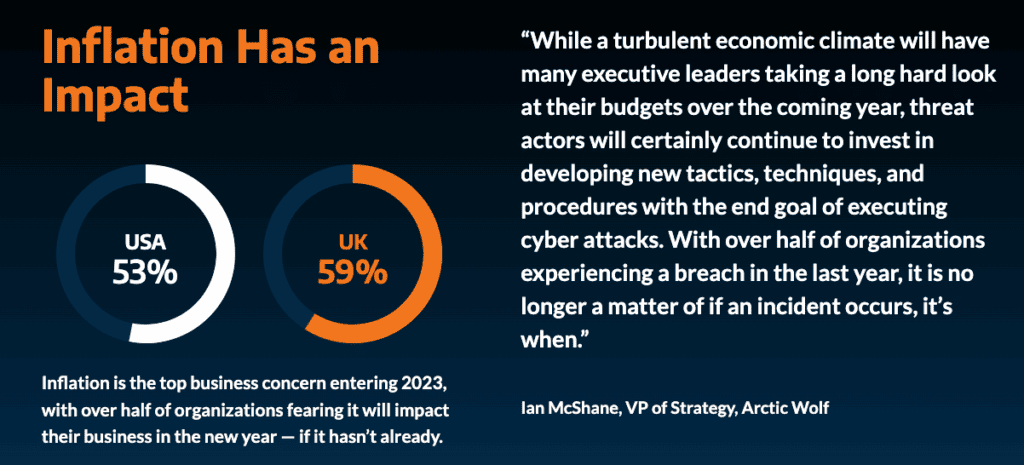It’s been splashed across headlines and popped up in social media statuses — organisations are evaluating budgets and laying off staff.
These layoffs, which have hit departments like marketing and IT across a variety of industries, are more than anecdotal. Our global survey, which took responses from 920 decision makers at enterprises with more than 1,000 employees showed that there is a major shift happening in internal spending and hiring. Inflation and talent shortage are the top two concerns heading into 2023, and due to those concerns (as well as economic headwinds), 62% of businesses had to lay off employees in the past year.
But layoffs don’t offer the full monetary picture. Organisations are still increasing cybersecurity budgets, even as staff shortages increase and spending across the remainder of departments tightens, which means it’s more important than ever that these organisations think strategically about what their cybersecurity should look like and what their money should be spent on.
The answer may not lie with internal staffing or more tools, but with a security operations solution.
Businesses Are Struggling with Staffing
Due to a variety of factors — stock market instability, rising inflation, and even the war in Ukraine — organisations have had to let employees go over the past year. As mentioned above, over half of businesses surveyed saw layoffs. While the top department affected was sales and marketing, it’s the second department most impacted, IT and security, which can cause cybersecurity concerns.
As organisations grow, digitise, and adapt in a rapidly changing cybersecurity environment, security staffing becomes critical. Threat actors are gaining sophistication and attacks are increasing every year. If organisations are cutting security staff, they may be saving dollars in the short term, but that budget could get hit hard if a data breach occurs. Ransomware payments, downtime, and regulatory fines carry with them large price tags. In fact, the average cost of a data breach in 2022 was $4.35 million.
Not only could this staffing shortage leave organisations vulnerable to attack, but it also only increases the security and cloud security skills gaps. Even though businesses had to lay off employees, they are still concerned about “talent shortages,” with 41% of organizations listing it as a top concern for 2023. It’s known that the security skills gap is widening, and these empty positions could further widen that gap. It also means that internally, the organisation’s security journey is at a standstill. There’s no increase in skills or the security posture if staff is cut.
However, organisations understand that cyber attacks aren’t going anywhere and appear to be adjusting their budgets to meet this evolving threat landscape.
Despite Staffing Issues, Organisations are Upping Budgets
It may seem counter intuitive to both lay off employees while increasing budgets, but that is exactly what is happening.
76% of organisations surveyed are planning to increase their budgets, with the top two industries being finance (82%), and government or public sector (64%). Both of those industries listed “continued cyber attacks” as their number one concern for 2023, and, at least for government entities within the U.S., there’s been renewed efforts to increase regulations, cybersecurity requirements, and funding for cybersecurity.
The increase in budgets is warranted, 89% of organisations stated they have been targeted by malicious messages in the past 12 months, and 59% of those messages were suspected phishing messages. In addition, 52% of enterprises experienced a security incident in the past year. 36% of those incidents were business email compromise, and 35% were cloud breaches.
Attacks are only increasing, so organisations need to improve their defenses. But how should these organisations spend their budget if economic headwinds and inflations have forced them to let staff go, creating a major cybersecurity gap? The answer lies in external security operations.

Why Security Operations Are the Smart Investment
Working with an external security operations partner can solve both the budgeting issue and the staffing issue. For large enterprises like the ones surveyed, building and sustaining a full security operation fully in-house just isn’t possible. From the ongoing talent shortage to the economic instability, it’s difficult to train and retain staff, and it’s expensive to operate on the 24×7 scale (while managing multiple solutions) needed by many organisations.
An external partner, however, offers skilled staff, 24×7 monitoring, and can be a more cost-effective option that eliminates the need for further investment in technology solutions.
Organisations know that they need to put more money into cybersecurity, so the question is “where?” Internal staff is expensive, and as mentioned above, there’s an on-going skills gap. Technology solutions are not fully effective if there aren’t staff to manage them, plus more tools can lead to alert fatigue, de-centralised operations, and can create risk through misconfigurations.
An interesting note from the survey is that 47% of organisations stated the blame for a cyber incident should lie with the cybersecurity team. If your organisation isn’t fully investing in one, then you can’t really rely on them to stop that incident. An external partner offers both reliability and accountability.
Learn more about the global survey.
Learn more about how security operations accelerate your organisation’s cybersecurity with “A Security Leader’s Guide to Leveraging MDR for Security Maturity and Development.”






